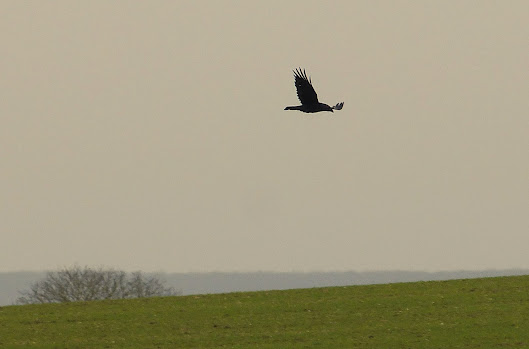Saturday 6th April 2024.
It was a touch of mixed fortunes today as we scoured the north-west Hampshire countryside for the Stone-curlews. Despite trying three areas, there was no sign of the birds, though the strong blustery south-westerly wind did not help and made viewing quite difficult at times and we assumed the birds simply hunkered down to keep out of the wind. Nevertheless, I got another ‘year-tick’ and Andy Fisher grabbed another three more ‘year-ticks’. Andy also had a good selection of moths to look at too.
The Moth Boxes:
What I thought would of been a good evening for moths here in Southsea actually turned out to be a disappointment. I had not one moth in or around the moth box, with just a couple of damn Snails in the box instead! Hurrumph! However, Andy’s moth box saved the day when he had 22 moths of 10 species that included a superb Waved Umber; only the 3rd of this species I have ever seen. The moths present this morning by his moth box included the following:
- Waved Umber 1 (New For Year)
- Brimstone Moth 2 (NFY)
- Brindled Pug 2
- Double-striped Pug 4
- Early Grey 4
- Hebrew Character 1
- Common Plume 4
- Ruddy Streak 1 (NFY)
- Narrow-winged Grey 1 (NFY)
- Twenty-plume Moth 2 (NFY)
North-west Hampshire:
We arrived at our first destination in a site in north-west Hampshire and understandably, Stone-curlews as Schedule 1 species that are protected by law and therefore I cannot disclose the exact location of the breeding birds. Parking up, we had to negotiate a very muddy track full of deep puddles, which was a task in itself. However, we were rewarded with at least two singing male Blackcaps, a male Yellowhammer, a few Long-tailed Tits and a Chiffchaff. Dandelions were all along the footpath and most had a Bees on them, notably Chocolate Mining Bee’s and a few others of which I could not grab a photo of. It didn’t take long to find our first Corn Bunting of the morning, a singing bird on some railings, but it was very distant. About ten minutes later, another bird popped up, singing its heart out and came closer and closer. In fact, it turned out that the Corn Buntings were abundant here and we even saw a flock of birds flying over a cereal crop numbering around 8 birds!
Both Common Buzzard and Red Kite were seen regularly flying over the countryside here and the occasional Kestrel would fly past as well. Earlier this morning, Geoff Farwell and I saw a female Merlin fly over the A3 as we made our way to Andy’s house and a female Sparrowhawk was seen soaring over a town nearby. Another good day for raptors, despite the strengthening wind. Walking up to the first site, several Brimstone butterflies were seen flying along the bridlepath along with a few probable Peacocks and one I was pretty sure was a Small Tortoiseshell. When we reached the site, we kept our distance as I scanned the area thoroughly. But there was no sign of any Stone-curlews. However, we did find a pair of Common Partridge and later that morning, a pair of Red-legged Partridges were seen. Skylarks kept coming over and landing on the site and Corn Buntings and Yellowhammers were singing all around us. Andy got his first Swallows of the year as a small flock of 3 birds flew over our heads and more were seen later in the day. A pair of Ravens flew low over the fields and headed off south. We tried our luck further north and though we saw many more Corn Buntings, there was no sign of any Stone-Curlews and so returned back to the car and have a spot of lunch.
It was during lunch that fellow ‘Lazee Birder’ Ollie Crabbe and one his friends pulled up in their car and they kindly gave us a location for another Stone-Curlew site of which they had seen the birds earlier today. Of course, this info I will not disclose and so that was our next destination. On arrival, the site looked ideal, but that blasted horrible wind was near gale force at times and made viewing quite difficult. But despite a good hour here searching for the birds, it drew a blank again. For our efforts, I found a male Wheatear sheltering from the wind on the edge of the Square and so got Andy onto the bird for his first Wheatear of the year. A pair of Lapwings were present here and hopefully, will raise young here.
Geoff had one more trick up his sleeve as he knew of a site not too far away from Ollie’s site and so we headed off there. Yet again, there were no diamonds, but we did see a flock of 8 Fieldfares in a field and a pair of Corn Buntings flew over. It was now just after 4pm and I had to get back home and so called it a day. Geoff does a lot of birding in these areas and he is a fountain of knowledge when it comes to what birds are in the area. Not a bad days birding, though a shame we never got to see the Stone-curlews. Maybe I shall try again later in the month.
In Hampshire today, a male Ring Ouzel was seen by Portsdown Hill this morning and a good selection of common migrants were seen throughout Hampshire, including a Cuckoo reported today. There was even a reasonable seabird passage through the Solent with Bonxie, Common Terns and a few Divers passing through. Birding pal, John Goodall, kindly finished off two more Swift Nestboxes for me for a neighbour up my road, which I shall organise shortly to be installed.















No comments:
Post a Comment